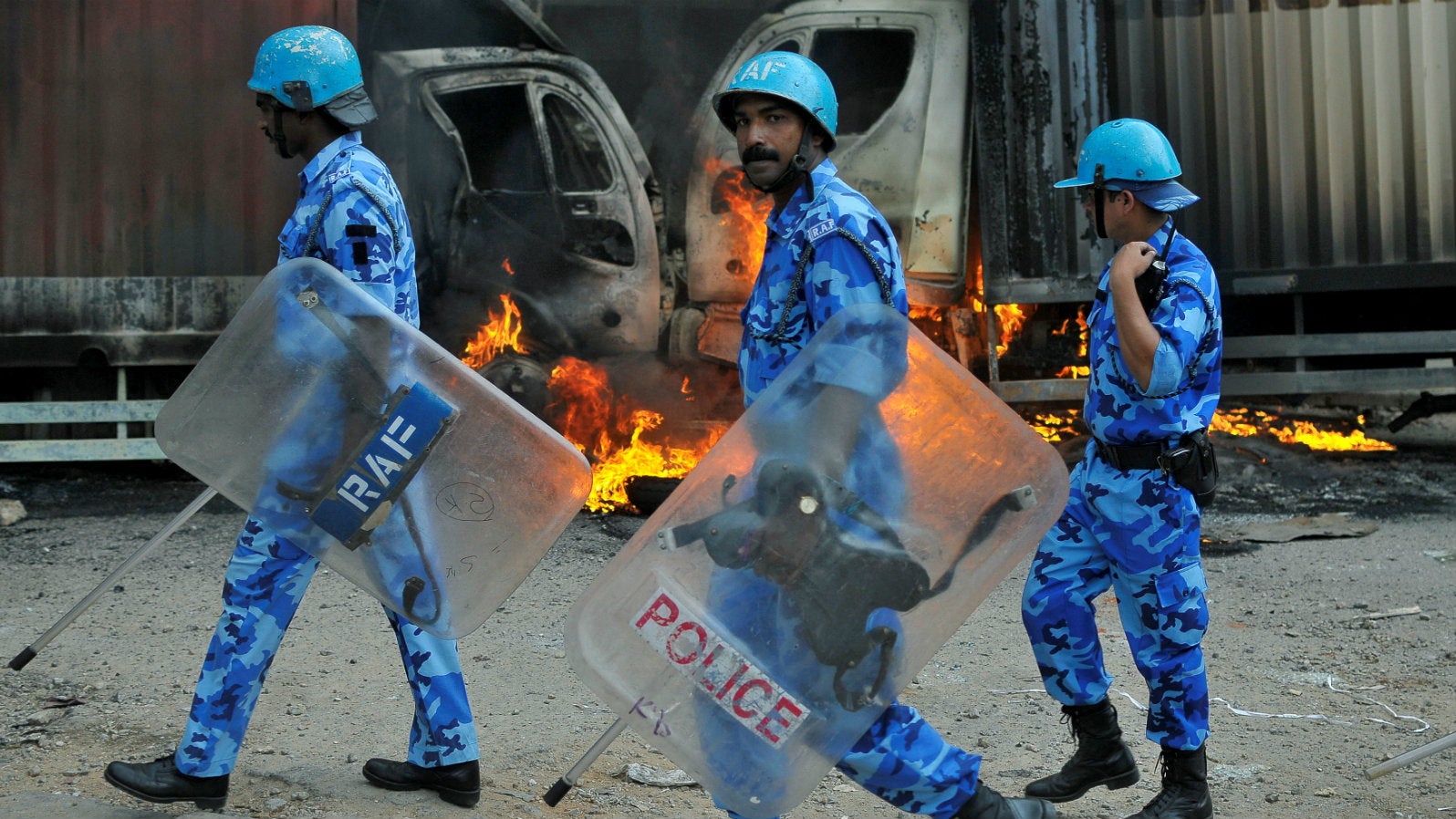A river sets fire to India’s Silicon Valley
After weeks of simmering tensions, the glass-and-steel modern facade of India’s Silicon Valley was finally shattered on Sept. 12 by primitive hatred, fueled by linguistic rivalries.


After weeks of simmering tensions, the glass-and-steel modern facade of India’s Silicon Valley was finally shattered on Sept. 12 by primitive hatred, fueled by linguistic rivalries.
Over the past few weeks, Bengaluru has been brought to a halt once before by citizens of the state of Karnataka over sharing the waters of a river with the neighbouring state of Tamil Nadu. On Sept. 12 violence erupted again, resulting in the death of one person in police firing.
The protests across Karnataka by Kannada-speakers were sparked by the supreme court’s order to release 12,000 cusecs of water from River Cauvery to Tamil Nadu every day until Sept. 20. This was a reduction from the previously-decided amount of 15,000 cusecs, which itself had prompted a state-wide bandh on Sept. 9
On Sept. 12, Bengaluru saw lumpen elements vandalising business establishments of the city’s Tamil-speaking residents. This included popular eateries such as the Adyar Ananda Bhavan sweet shop on Mysuru Road and the Murugan Idli Shop in the tony Indiranagar neighbourhood.
Vehicles owned by Tamil Nadu-based transport operators bore the brunt. Thirty-five buses with Tamil Nadu registration plates were set alight and services between the two states were suspended. Cars, trucks, and buses with Tamil Nadu registration numbers were attacked in other areas of southern Karnataka, too. In Mysuru, one Tamil family was reportedly pulled out of the car it was travelling in and the vehicle set ablaze.
So grim was the situation that by 5pm the police issued an order prohibiting the assembly of people in large groups across the city.
However, in a shocking display of chaos, such measures were largely ineffective.
This violence is said to be a reaction to incidents in Tamil Nadu in the past few days where Kannada speakers’ businesses and vehicles were targeted. Early on Sept. 12, members of an unidentified pro-Tamil group hurled a petrol bomb on the New Woodlands Hotel in Chennai. Cars ferrying Kannada-speaking pilgrims were vandalised in the town of Rameswaram in Tamil Nadu.
The violence in Tamil Nadu itself was allegedly in retaliation to the assault on a Tamil student in Bengaluru who allegedly took to Facebook to criticise actors from Karnataka for their stance on the Cauvery dispute. He was beaten up severely on Sept. 10 and the video of the assault went viral online.
Not the first time
This isn’t the first time that the local Kannadiga population and the Tamils have fought each other. In 1991, twenty-eight people were killed in Bengaluru and Mysuru while thousands of Tamil families fled Karnataka in fear after a tribunal asked Karnataka to release the Cauvery’s waters to Tamil Nadu. Educational institutions were shut down for nearly a month back then and the loss to property was estimated at around Rs19 crore at that time.
In July 2000, violence erupted again when the revered Kannada matinee idol, Rajkumar, was kidnapped by forest brigand Veerappan—a Tamil speaker. Bengaluru’s Tamilians were again targeted by angry protesters.
Tamils in Bengaluru
While Karnataka is predominantly Kannada-speaking, Tamil speakers have lived in the region for centuries. Home to other linguistic communities such as Telugu, Malayalee, Konkani, Urdu, and Marathi speakers as well, Bengaluru has recorded the presence of Tamils at least since the 16th century.
Some estimates say that till 1991, Tamils formed the biggest linguistic chunk in Bengaluru. This apparently changed following the violence over the Cauvery that year. Yet, Tamil speakers still constitute a large section of Bengaluru’s nearly 10 million population.
Stretched resources
Known by several epithets such as India’s “Garden City” and “Pensioners’ Paradise” till a few decades ago, owing to its salubrious weather and intellectual and industrial base, Bengaluru has witnessed dramatic change since the 1990s following India’s infotech boom centered around the city.
While today it hosts cutting-edge innovations in technology and has often pioneered the latest in fashion, food, and other lifestyle trends, not much seems to have changed below the surface.
Despite the billions of rupees in investment that it attracts, hardly anything seems to have been done to conserve or bolster Bengaluru’s natural resources. Its infrastructure has hardly kept pace with the population, which, from around 4.1 million in 1991, more than doubled to 9.5 million by 2011. Indeed, the IT explosion saw an unprecedented influx of people from across India into the city, stretching its resources—particularly water.
Bengaluru almost entirely depends on River Cauvery for its water supply. The river is also the lifeline for a large chunk of southern Karnataka’s farmers. However, the Cauvery, which originates in the Kodagu district of Karnataka, is also important for Tamil Nadu where it flows into the Bay of Bengal. With the river drying up almost every summer, the sharing of water between the two states becomes a point of contention.
And every once in a while, it sparks such medieval violence—pricking Bengaluru’s pretence of modernity.